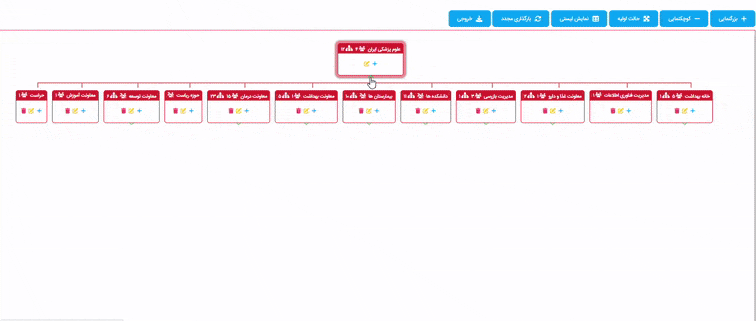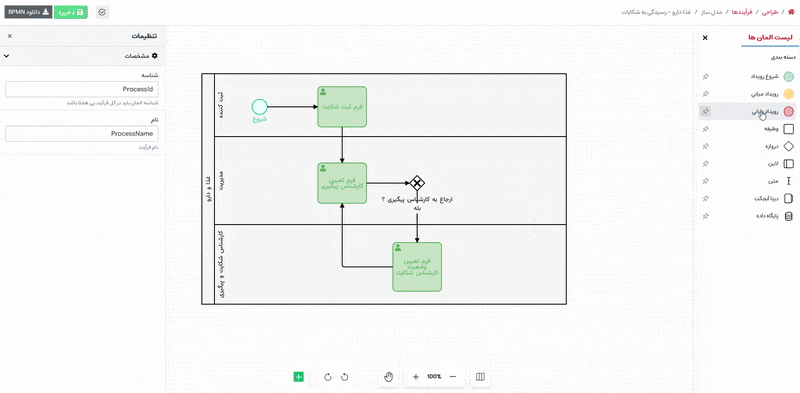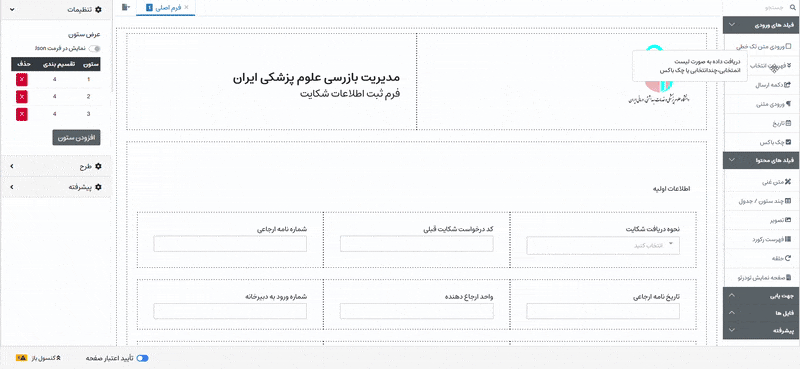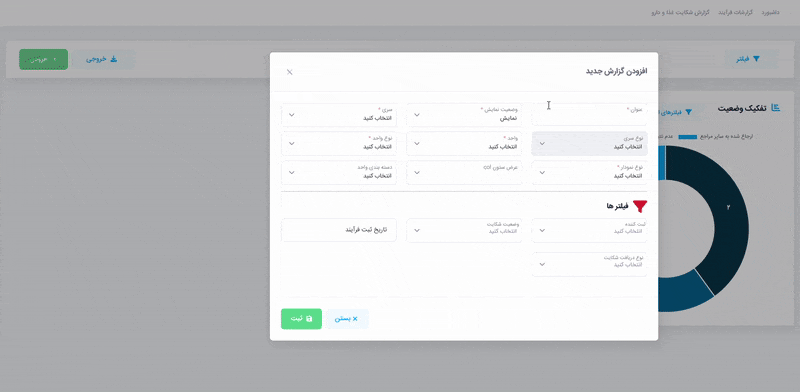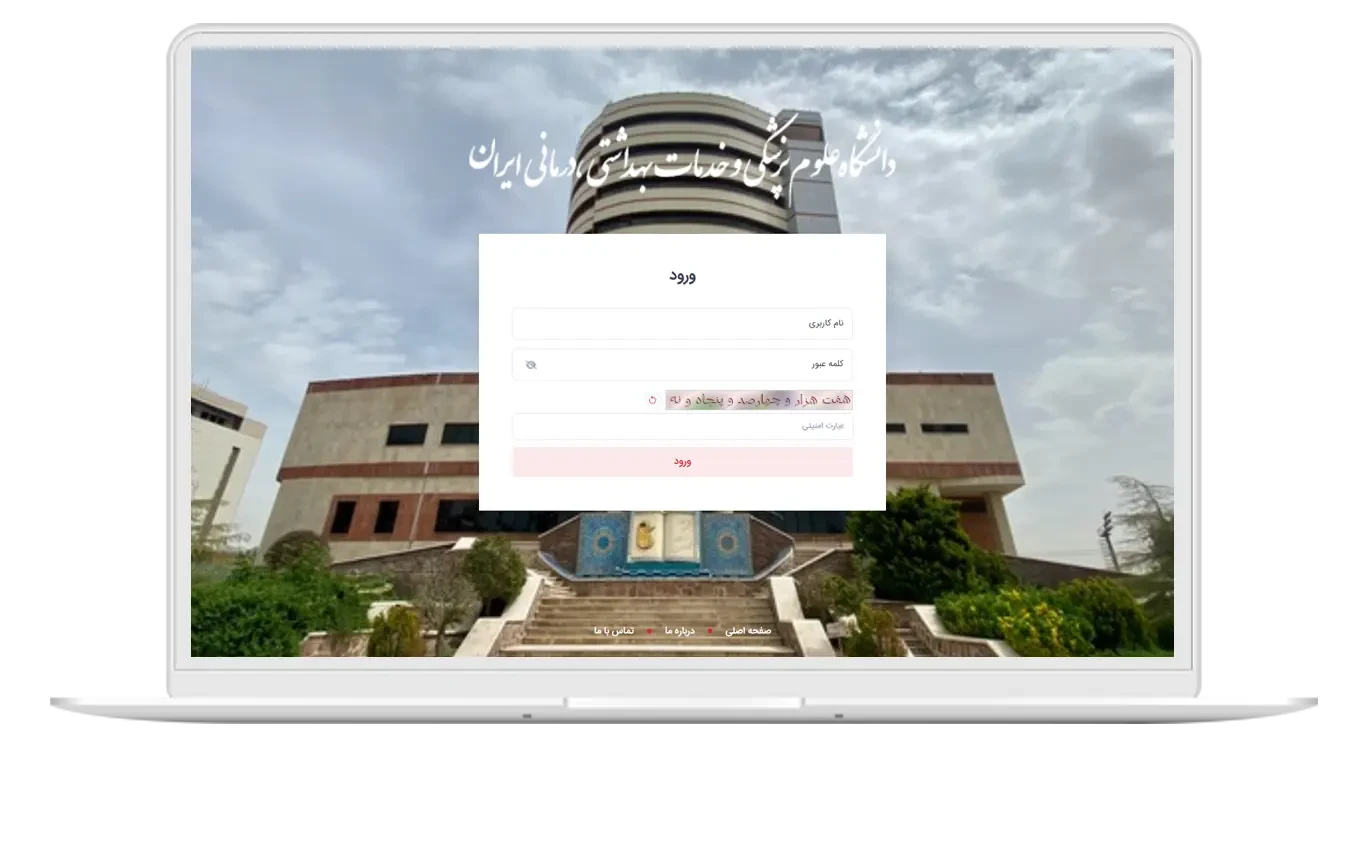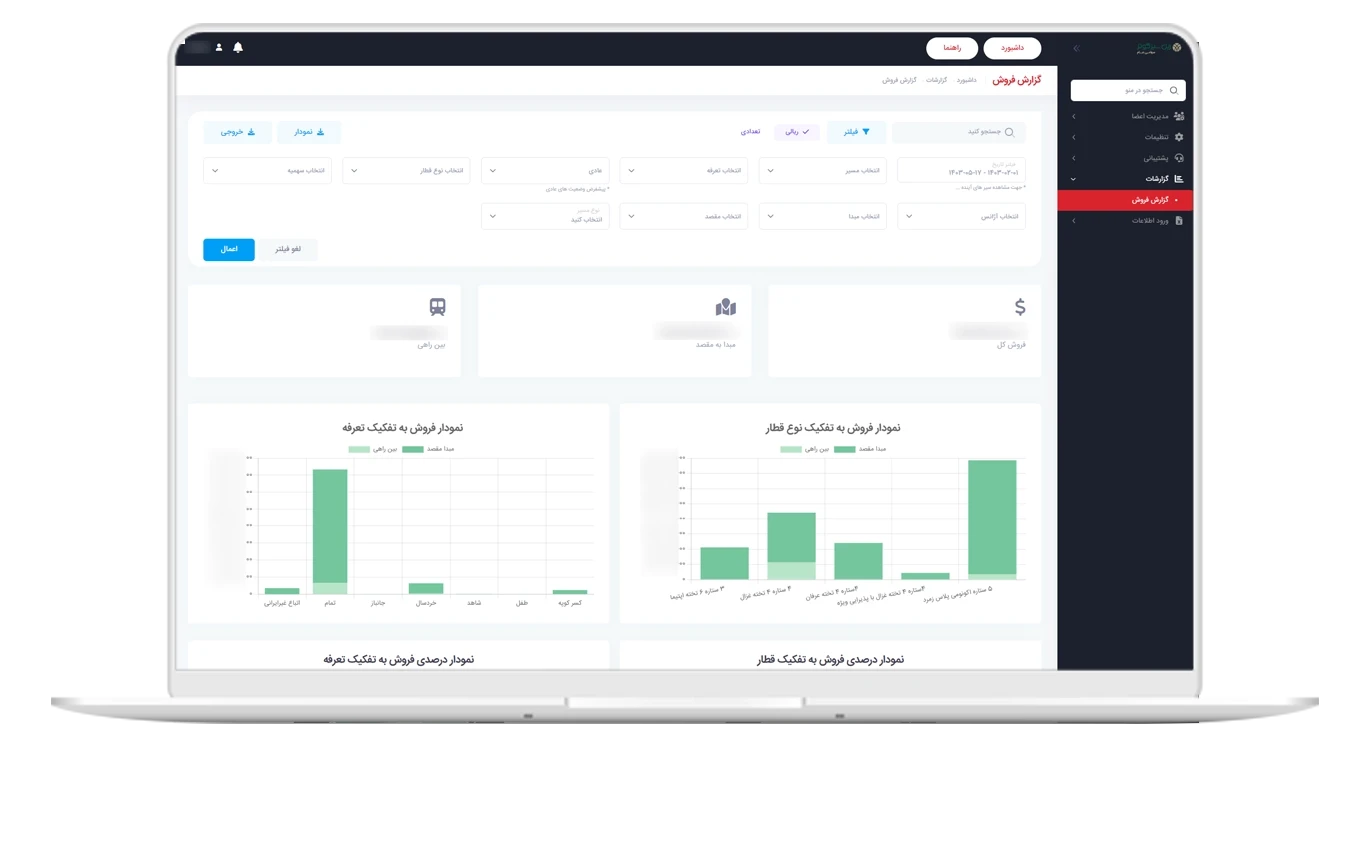The Business Process Management (BPM) and Business Process Management System (BPMS) systems help organizations optimize their processes, increase efficiency, transparency, and flexibility in their operations. These tools focus on the process lifecycle and utilize organizational automation and a workflow engine, enabling the efficient and integrated management of processes. Below, we will examine the benefits of using a dynamically managed process system and its role in improving Workflow Management.
Dynamic Business Management System
Workflow Design with Process Designer Tool
The dynamic process designer tool allows you to model and implement your organizational processes graphically. With this tool, you can define work steps, assign tasks between units, and manage process execution intelligently and without the complexities of coding.
Rapid Form Creation with Form Designer Tool
The dynamic form designer with Drag & Drop capability allows you to create various organizational forms on the web. In this tool, you can add and manage text, numeric, date, selection fields, and even data related to other forms to facilitate faster and more accurate data entry and registration.
Applying Smart Rules with Rule Builder Tool
With the rule builder, you can apply your business logic and rules conditionally or computationally within the system. This tool allows you to define variables, perform calculations, display errors, and control the behavior of forms and processes without the need for programming changes.
Managing Organizational Structure with Organizational Chart
The dynamic organizational chart helps you define the hierarchy of the organization along with units, positions, and user roles. This capability ensures that processes and tasks are automatically assigned based on the actual organizational structure, simplifying human resource management.
Task Management in Smart Task Dashboard
The dynamic task dashboard displays all tasks and requests in a centralized user environment. Users can view, track, and perform their tasks, while managers can monitor and control the flow of activities with access to employee dashboards.
Reporting and Data Analysis with Report Generator
The dynamic report generator provides the ability to create various management and analytical reports based on system data. Managers can create custom reports, examine the status of processes, and make smarter decisions for improving organizational performance by analyzing bottlenecks and execution times.
Some Other Features of Dynamic Business Management
- Designing and implementing processes based on BPMN 2.0 standards
- Starting processes based on various events (form save, status change, signals, webhooks, specific dates and times, etc.)
- Defining and using sub-processes in various workflows
- Applying Business Rules and complex conditions in processes
- Pausing a process and continuing its execution based on defined events
- Defining automatic operations (Actions) and automatically executing tasks
- Defining manual operations and sending tasks to the personal task dashboard, role, position, or senior manager
- Managing hierarchical approvals based on the organizational chart
- Setting SLA and determining the deadline for each stage in the process
- Sending and receiving messages via email and SMS
- Automatically sending tasks if the user does not take action within a specified time
- Designing and managing organizational structure, roles, and users in the system
- Full integration with internal systems and external services via REST and SOAP
- Managing different versions of processes and the ability to provide comparative reporting between versions
- Defining polling and group decision-making based on percentage or number parameters
- Tracking, monitoring, and accurately reporting the status of each process in real time
- Defining access rights and roles according to organizational access rights
- Executing C#, PHP, and JavaScript code at runtime
- Full integration with ERP systems and other platforms via API and Integration Hub
- Designing an intelligent data structure without manually creating data tables and entities (data structure is created automatically with form design)
- Designing interactive forms via Drag & Drop without the need for coding
- Support for various fields: text, numeric, date, tables, digital signature, selection (Dropdown, Radio, Checkbox), etc.
- Ability to connect fields to process variables and external data
- Advanced validation for data accuracy control
- Using conditional logic to display or hide fields
- Supporting file uploads and attaching documents in the form
- Displaying forms in a fully responsive environment suitable for mobile and desktop
- Ability to reuse forms in different processes
- Adding calculations and business logic in fields
- Connecting to APIs and web services for receiving or sending data in forms
- Ability for multilingual forms
- Designing multi-step forms for stepwise information registration
- Temporarily saving data and continuing to fill out the form later (Draft Saving)
- Capability to use templates and ready-made elements for faster design
- Ability to design information collection forms without creating a process (Crud)
- Reporting and filtering on all fields designed in the form
- Defining and implementing business rules without the need for coding
- Support for complex conditions and multi-layer decision-making
- Ability to define variables and use them in rules
- Support for loops, calculations, and logical operations
- Automatically applying rules in forms and processes
- Managing errors and displaying appropriate messages to the user
- Quickly editing rules and viewing changes in real time
- Simplified design of various simple and complex reports without the need for query writing
- Creating custom reports based on process data
- Supporting analytical, graphical, and tabular reports
- Supporting segmented reports
- Generating QR CODE for authentication of output reports
- Displaying KPI and key performance indicators
- Designing management dashboards and assigning access based on the organizational chart
- Identifying bottlenecks and delays in processes
- Ability to schedule reports and send them automatically via system notifications, email, SMS
- Applying access levels on reports based on the designed organizational chart
- Exporting to PDF, Excel, and CSV formats
- Displaying a real-time management dashboard
- Creating various dashboards based on the organizational chart (applying hierarchical access levels throughout the system)
- Defining the organizational structure along with units, positions, and roles
- Automatically assigning tasks based on the organizational structure
- Managing hierarchical approvals
- Defining substitutes for individuals in absence
- Complete integration with human resources and ERP systems
- Ability to change and update structure without negatively impacting processes
- Displaying tasks and requests in the personal task dashboard
- Ability to approve, reject, or refer tasks to others
- Ability to draft in forms
- Automatically sending tasks if no action is taken within a specified time
- Recording notes, attachments, and comments in each task
- Smart notifications through system alerts, email, and SMS
- Managers' access to employee dashboards for monitoring
- Ability to prioritize and filter tasks
- Viewing complete history of processes and submitted forms
- Exporting submitted forms in the process as PDF and WORD
- Displaying a summary of process requests in the task dashboard (based on the designed dynamic form)
Some Clients
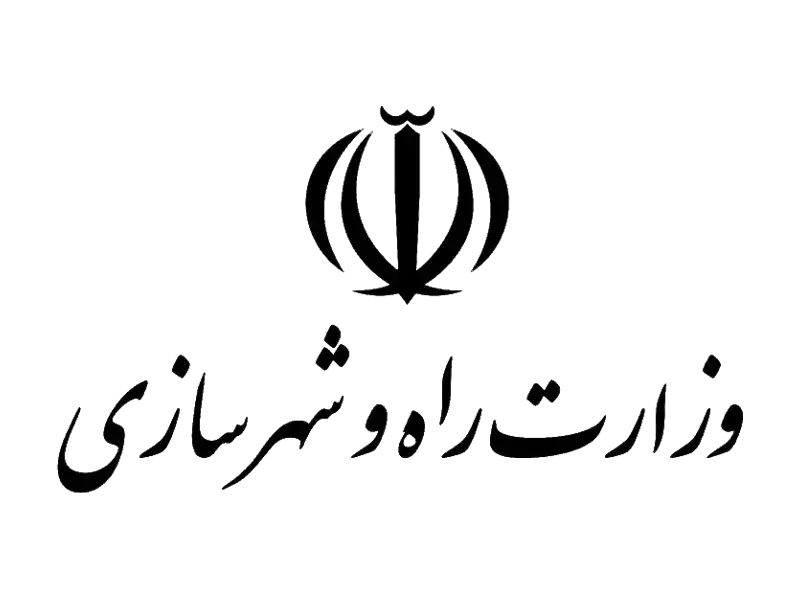
Smart Service Desk of the Ministry of Roads
The Smart Service Desk of the Ministry of Roads and Urban Development has been designed and implemented to facilitate citizen access to government services and reduce administrative formalities. This system, utilizing modular architecture and modern infrastructures, provides diverse, secure, and integrated services for the general public.
Project Details
Monitoring and Evaluation System of Iran University of Medical Sciences
This system has been designed and implemented using the dynamic BPMS software, helping Iran University of Medical Sciences to intelligently and integratively manage its monitoring and evaluation processes. This project was executed with the aim of enhancing the efficiency, transparency, and quality of healthcare services and is considered an important step in the digital transformation of the health sector.
Project Details
Center for Assembly Affairs and Contract Oversight System
The "Management of Assembly and Contracts System of the Ministry of Roads and Urban Development" has been designed and implemented to increase transparency, facilitate monitoring, and improve efficiency. This system covers tasks such as holding general assembly meetings, managing contracts, recording board resolutions, managing documents, and financial statements.
Project DetailsWhy Dynamic Process Designer?
The dynamic process designer, by leveraging Business Process Management (BPM) and Business Process Management System (BPMS), increases organizational efficiency. This tool optimizes costs by streamlining processes, eliminating unnecessary steps, and reducing errors. The workflow engine improves coordination between departments and enhances flexibility against market changes. Standardizing processes and continuous monitoring of the process life cycle enhances service quality. Additionally, organizational automation and analytical reports ensure transparency and quality control. The dynamic process designer is a comprehensive solution for efficient and competitive management.
With the dynamic process designer, design and implement all your organization's processes and forms in the simplest way possible, using only Drag & Drop without the need for coding.
Based on pre-prepared settings and tools according to the needs of large organizations such as organizational charts, manage and configure the system in the simplest possible way.
Based on customer needs assessment, it offers the best user experience (UI/UX). Benefit from all the system's capabilities easily and without technical knowledge.
Easily connect with various tools to other parts of your organization and systematize workflows and consolidate data for statistical and analytical reports.
Ease of Designing Processes in Dynamic Business Management
for managing workflows, information access levels, etc.
delegation rules and workflows in the process.
information from various sources to display in the form.
check the status of the process, data, and various reports.
